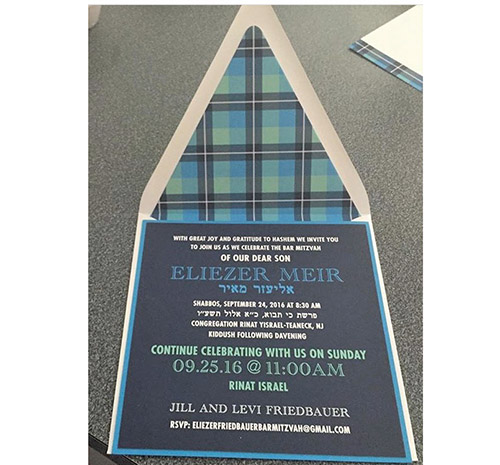


Mazel tov on a simcha! Whether it’s a bar mitzvah, bat mitzvah, baby announcement, wedding or anything else, lots of decisions have to made, including the decision about how to publicize the event.
More and more families have made the choice to “go paperless” as they say, and use online services exclusively for their invitation needs. But for all that this seems to be the emerging trend, many families still choose real invitations that can be mailed over the online versions.
“Digital printing changed the market completely,” explained Simone Wruble, owner of The Write Event, a party invitation company. “It allowed us to be infinitely more creative while at the same time offering these options at prices more affordable than ever.” For over 20 years, Wruble has been making invitations to help families celebrate their exciting events, and now designs wedding invitations and birth announcements for customers whose bar or bat mitzvah invitations she once designed. At the same time, Wruble has watched the many shifts in the invitation business. What was once a simple typeset and paper choice, with barely any colors to choose from has become a world of endless options. Wruble taught herself graphics programs to stay current and offer many creative options in keeping with the times.
“I love the ability to make things so much more personal,” Wruble said. “With more colors and options than ever before, invitations have the ability to become a reflection of the person.” She recounted the early days of bar mitzvah invitations, where the standard was blue, white and maybe silver, or black and white, and no one would deviate from this color set. Now, anything can be done—and is done—and Wruble loves the fun involved in the process.
“There’s something to be said for the feel of an actual invitation—the texture, the weight—in your hand,” said Wruble. Apparently, she’s not the only person to feel this way, and even those in the paperless world had similar sentiments. In 2013, just four years after Paperless Post launched their successful model, they partnered with Crane Paper, a company known for their unique textures and styles, because apparently, it seemed that even with a completely functional digital invitation experience, people still wanted (gasp) real invitations.
Using real invitations combats some of the challenges people have found in the paperless arena. Anyone who has received a digital invitation also has the issue of remembering the date when it is not hung up on a fridge somewhere, and that is making the assumption that the invitation does not get lost in spam or e-mail clutter in the first place.
For the sender, replies have their own set of etiquette in the paperless world. If they see someone opened the invitation (since that information is available), at what point can the host ask for a response back and assume the person forgot to respond? With mailed responses, people are more likely to send it back—it’s already been stamped too—and possibly even include a check right then and there. In fact, the Wall Street Journal wrote an article a few years back about the changing dynamics in RSVPs thanks to digital invitations. They described the phenomenon of “maybe” becoming a completely acceptable—but impossible to plan around—response for Evite and similar programs.
While digital invitations have become increasingly popular for bar and bat mitzvahs, weddings still follow traditional invitation models and use paper. But even in that area, the shift is noticeable. If someone wants the look of layered papers but has a tight budget, “there is so much that can be done to frame the invitation and make it look multi-layered,” Wruble said. “The possibilities are endless, at any price.”
By Jenny Gans













